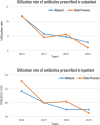A qualitative study of the factors impacting implementation of the national action plan to contain antimicrobial resistance (2016-2020) in medical institutions
- PMID: 38254103
- PMCID: PMC10804545
- DOI: 10.1186/s12913-023-10404-y
A qualitative study of the factors impacting implementation of the national action plan to contain antimicrobial resistance (2016-2020) in medical institutions
Abstract
Objective: Antimicrobial resistance (AMR) has emerged as a serious global public health crisis. In response, 2016, 14 ministries in China, under the leadership of the National Health Commission, collaboratively issued the National Action Plan (NAP) to Contain Antibacterial Resistance (2016-2020). The NAP outlines strategies for medical institutions to adopt stewardship and implement AMR control. The purpose of this study was to comprehend stakeholders' perceptions of the NAP and explore the factors that influence its implementation in medical institutions.
Methods: Semi-structured interviews were conducted with practitioners from medical institution in March and April 2021. Interviews were audio-recorded, transcribed and analyzed using thematic analysis via the framework approach.
Results: Twenty practitioners, representing diverse roles (4 administrators, 7 clinicians, 3 microbiologists, 3 pharmacists, 3 nosocomial infection management personnel) from seven institutions, participated in the study. Substantial efforts have been undertaken to regulate the rational use of antibiotics and enhance the management of hospital infections. Participants demonstrated awareness and concern regarding antimicrobial resistance, with widespread support expressed for the NAP. Among all professions, there were varying opinions on whether they felt restricted in their daily work. The tertiary hospitals have established multidisciplinary cooperation mechanisms. Six main themes were identified as both barriers and facilitators to the implementation of the NAP in the medical institutions: individual factors, leadership, multidisciplinary collaboration, patient factors, training and culture. The capacity for administrative attention is constrained or limited, poor enforcement of guidelines, insufficient specialist staff and the liability pressure on clinicians were perceived barriers. To containing AMR in medical institutions, management of hospital infections, the public's knowledge of antibiotics' usage, routine education and multidisciplinary support would be facilitators.
Conclusions: Practitioners from medical institutions were highly supportive for the NAP. Consideration of practitioners' perceived barriers and facilitators might enhance implementation of the NAP to contain antimicrobial resistance.
Keywords: Antibacterial agents; Antimicrobial resistance; Medical institution; The national action plan.
© 2024. The Author(s).
Conflict of interest statement
The authors declare no competing interests.
Figures




Similar articles
-
Attitudes and beliefs of Australian emergency department clinicians on antimicrobial stewardship in the emergency department: A qualitative study.Emerg Med Australas. 2019 Oct;31(5):787-796. doi: 10.1111/1742-6723.13251. Epub 2019 Mar 28. Emerg Med Australas. 2019. PMID: 30920181
-
Opportunities and challenges in antimicrobial resistance policy including animal production systems and humans across stakeholders in Argentina: a context and qualitative analysis.BMJ Open. 2024 Jun 17;14(6):e082156. doi: 10.1136/bmjopen-2023-082156. BMJ Open. 2024. PMID: 38889938 Free PMC article.
-
Progress on the national action plan of Pakistan on antimicrobial resistance (AMR): a narrative review and the implications.Expert Rev Anti Infect Ther. 2022 Jan;20(1):71-93. doi: 10.1080/14787210.2021.1935238. Epub 2021 Jul 26. Expert Rev Anti Infect Ther. 2022. PMID: 34038294 Review.
-
Fighting Antimicrobial Resistance and Healthcare-Associated Infections in EU-JAMRAI: The One-Health Response from Italy.Chemotherapy. 2024;69(1):56-64. doi: 10.1159/000531684. Epub 2023 Sep 6. Chemotherapy. 2024. PMID: 37673044
-
A road-map for addressing antimicrobial resistance in low- and middle-income countries: lessons learnt from the public private participation and co-designed antimicrobial stewardship programme in the State of Kerala, India.Antimicrob Resist Infect Control. 2021 Feb 11;10(1):32. doi: 10.1186/s13756-020-00873-9. Antimicrob Resist Infect Control. 2021. PMID: 33573697 Free PMC article. Review.
Cited by
-
Bibliometric analysis of global research on the clinical applications of aminoglycoside antibiotics: improving efficacy and decreasing risk.Front Microbiol. 2025 Feb 19;16:1532231. doi: 10.3389/fmicb.2025.1532231. eCollection 2025. Front Microbiol. 2025. PMID: 40046300 Free PMC article.
-
Distribution of Nosocomial Pathogens and Antimicrobial Resistance among Patients with Burn Injuries in China: A Comprehensive Research Synopsis and Meta-Analysis.Infect Dis Ther. 2024 Jun;13(6):1291-1313. doi: 10.1007/s40121-024-00983-6. Epub 2024 May 9. Infect Dis Ther. 2024. PMID: 38720132 Free PMC article.
-
Promoting real-world evidence use for antimicrobial stewardship in Latin America: evaluation of impact of a two-part educational webinar series.JAC Antimicrob Resist. 2025 Apr 18;7(2):dlaf056. doi: 10.1093/jacamr/dlaf056. eCollection 2025 Apr. JAC Antimicrob Resist. 2025. PMID: 40256650 Free PMC article.
-
Early Origins of Asthma and Allergies: Clues From Studies in China.Clin Exp Allergy. 2025 Aug;55(8):611-624. doi: 10.1111/cea.70033. Epub 2025 Mar 14. Clin Exp Allergy. 2025. PMID: 40087850 Free PMC article. Review.
References
-
- Ahmad M, Khan AU, Global economic impact of antibiotic resistance: A review. J Glob Antimicrob Resist. 2019;19:313–6. - PubMed
-
- Coule, Tracey. Theories of knowledge and focus groups in organization and management research. Qual Res Organizations Manage. 2013;8(2):148–62.
MeSH terms
Substances
LinkOut - more resources
Full Text Sources
Medical
Research Materials
Miscellaneous

